The NVIDIA SHIELD Android TV Review: A Premium 4K Set Top Box
by Ganesh T S on May 28, 2015 3:00 PM EST- Posted in
- Media Streamer
- Home Theater
- TV
- 4K
- Shield
- NVIDIA
Graphics Performance
While the SHIELD Android TV and the underlying Tegra X1 SoC are by no means slouches on the CPU side of matters, ultimately NVIDIA is still just another ARM Cortex implementer. On the other hand when it comes to GPUs, this is where NVIDIA truly shines. As NVIDIA is first and foremost a GPU company, and as a design philosophy always invests more time and die space into GPUs than any other SoC builder (save perhaps Apple X-class SoCs), they have always led the pack on GPU performance. And with the Tegra X1 packing a 256 CUDA core implementation of the very potent Maxwell GPU architecture, an estimated 1GHz clockspeed, and all the power and cooling it needs to keep from throttling, all of the ingredients are in place for a very strong showing from NVIDIA for GPU performance.
If there’s any real downside for NVIDIA and the SHIELD Android TV here, it’s that the Android GPU benchmarking situation hasn’t really caught up with what their GPUs are capable of. The standard benchmarks work, but game benchmarks are virtually non-existent, even in the AA and AAA games NVIDIA has helped bring over to the Android/SHIELD ecosystem. So we can’t for example look at the performance of The Talos Principle in the same way as we can the PC today.
Anyhow, we’ll start off with 3DMark’s Ice Storm Unlimited benchmark.
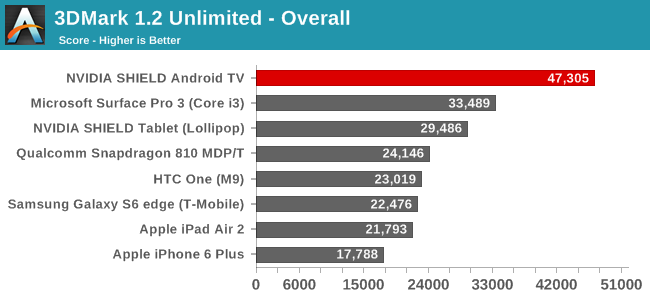
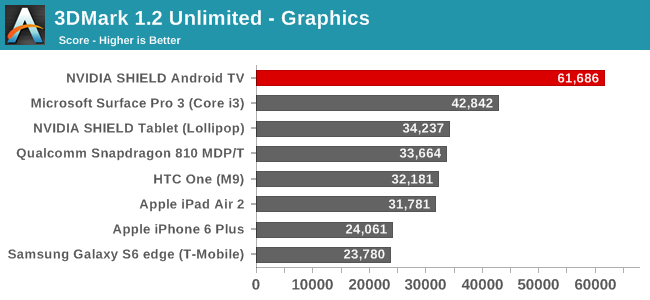
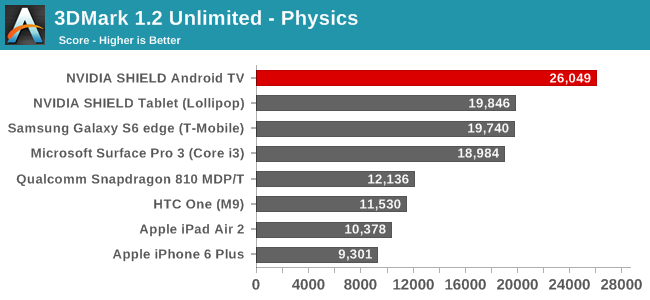
The results here pretty much speak for themselves, especially in the all-GPU graphics sub-score. SHIELD Android TV is 50% faster than the Surface Pro 3 and almost twice as fast as other devices like the iPad Air 2 and the last-generation SHIELD Tablet. Graphics workloads tend to be the most punishing from a heat and power standpoint, and hence are the most likely to get throttled. This really lets the SHIELD and its SoC open up here. At the same time, even in the physics score and the composite overall score, the SHIELD is well in the lead thanks to this combination of factors.
Up next we have BaseMark X 1.1.
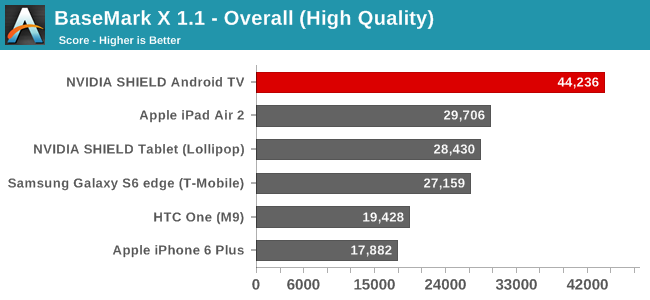
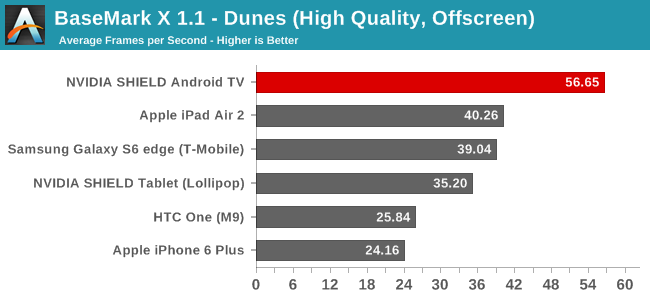

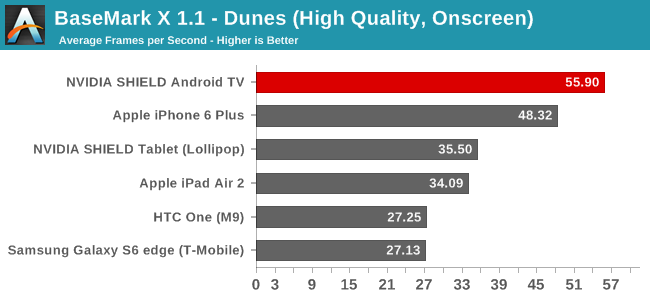
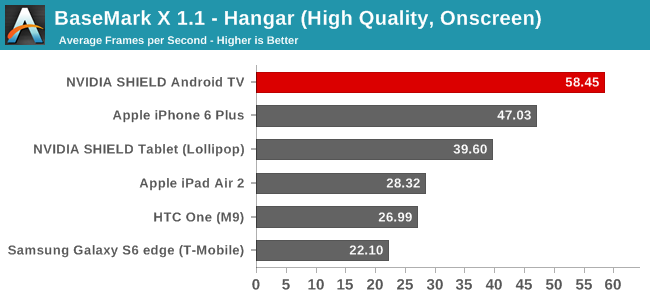
Once more it’s a clean sweep for the SHIELD. Apple’s iPad Air 2 tends to be the second-place finisher, thanks to Apple’s own significant investment in GPU resources, the SHIELD gets yet more resources and the power to fully exploit them. With all of that said, the one thing that does surprise me a bit here is that even the SHIELD can’t crack 60fps on Dunes and Hangar; BaseMark X will likely take one more generation before its tests can be completely beaten.
Our final GPU benchmark is GFXBench.

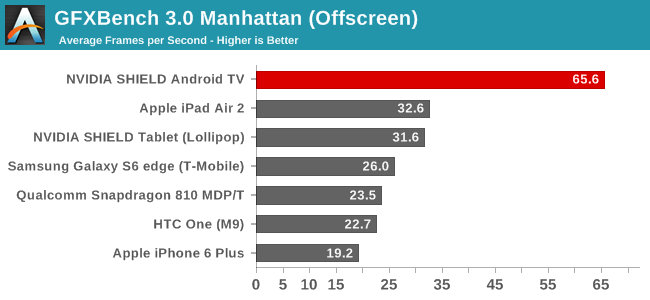
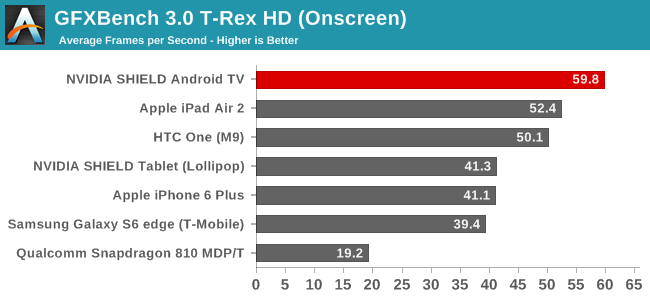
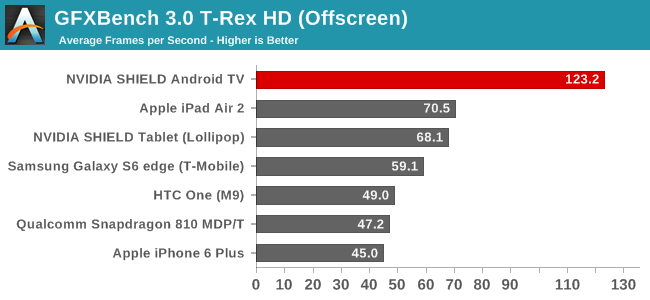
Starting first with the benchmark’s high-level tests, we once again find the SHIELD well in the lead. Of particular note here, the SHIELD Android TV becomes the first Android device to break 60fps on Manhattan, something that as recently as a generation ago seemed impossibly far away.
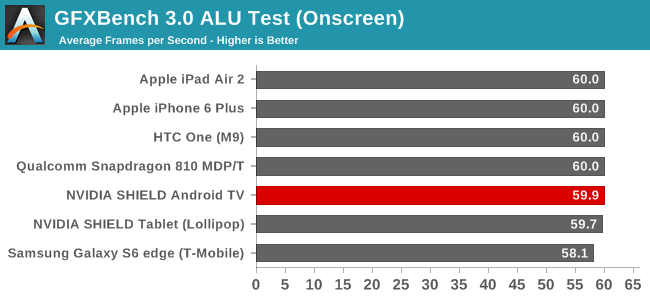
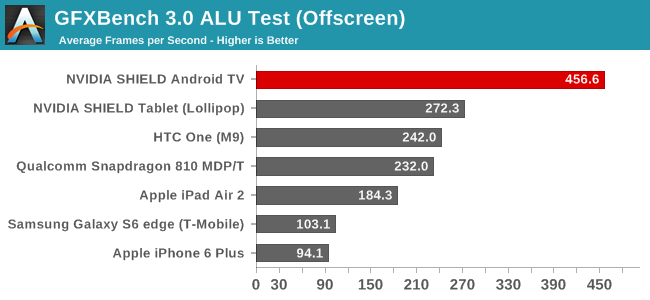

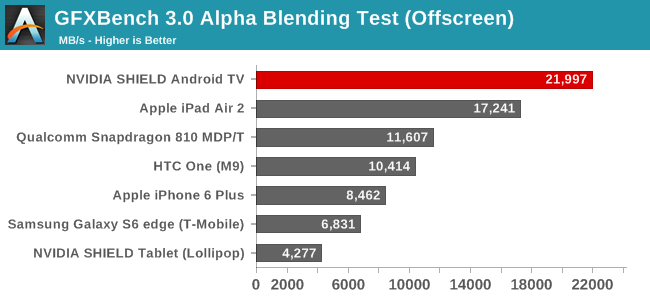
The low-level tests meanwhile offer us an interesting look at SHIELD and Tegra X1 that the high-level tests don’t provide. The ALU test for example drives home the point of just how much in the way of shading resources Tegra X1 has at its disposal (at least when unrestricted), and is a big reason why the SHIELD is doing so well here. On the other hand while NVIDIA still takes the top spot in alpha blending, the lead over the iPad Air 2 isn’t nearly as great, thanks in large part to the iPad’s relatively large 128-bit memory bus. Ultimately SHIELD doesn’t struggle here, but it’s an interesting point of comparison since it shows one of the only cases where SHIELD isn’t a run-away winner, and what kind of graphics workload may eat into its otherwise ridiculous advantage.
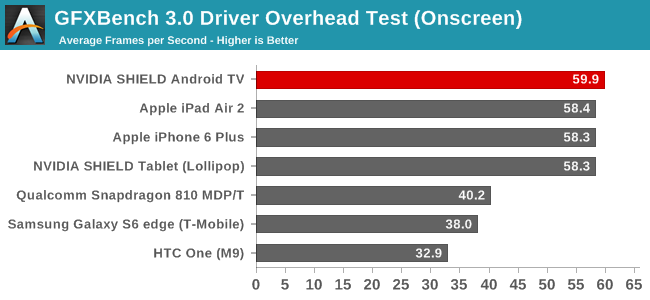
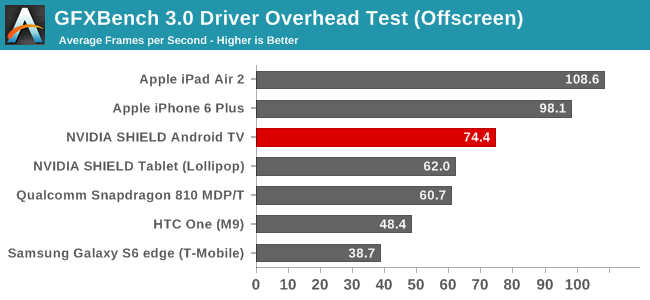
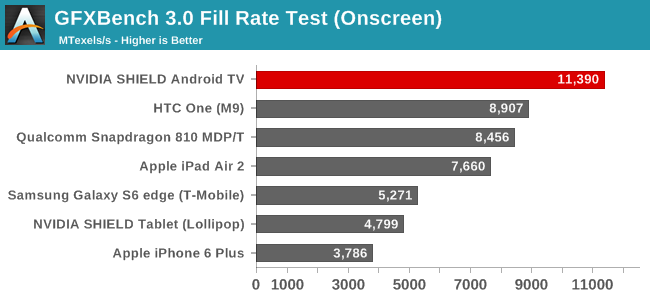
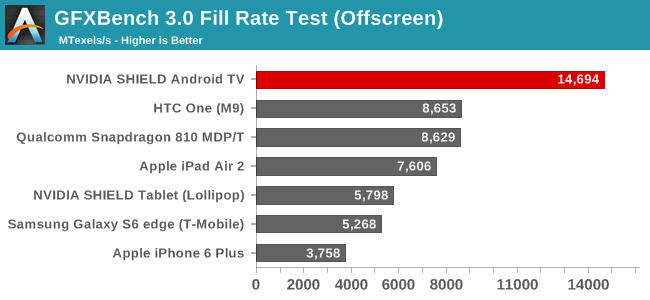
On the last batch of subtests, I’m going to stop again with the fill rate test just to point out another interesting design decision for Tegra X1 and the SHIELD. With NVIDIA banking so much on the set top box’s ability to drive 4Kp60 TVs, NVIDIA needs to push a lot of pixels to get there, as 4K is four-times as many pixels as 1080p. For this reason Tegra X1 is paired with 16 ROPs, giving it low-end PC desktop-like pixel throughput, and of course a huge advantage in the GFXBench fill rate test. And though this fill rate will help with games as well, it’s keeping up with the Android UI at 4Kp60 that is the most important reason for all of this fill rate performance.
Wrapping things up, what else is there to say about the SHIELD Android TV’s GPU performance? What we’re looking at here is twice as fast (or more) than the best phones and tablets today, a combination of the Tegra X1’s very strong GPU design and the set top’s practically unlimited energy and cooling capabilities. Overall NVIDIA is following the path they started long ago on Tegra, always favoring strong GPU performance, leading to the incredible performance we’re seeing here.
With that said, given NVIDIA’s decision to focus on the Android TV aspects of the SHIELD Android TV first and foremost – and not gaming – it’s also fair to say that the SHIELD is overpowered for Android TV work. Other than keeping up with the basic pixel fill needs of 4K, the real power of the box’s GPU is going to be left untapped by Android TV (especially on the ALU side). Which makes all of this humorously absurd in a way, but it’s also why SHIELD Android TV isn’t just an Android TV box. The device’s GPU performance will be put to good use with gaming, though stepping outside the world of benchmarks for a second, the bigger challenge NVIDIA faces is not delivering high performance, it’s delivering games that make full use of that performance.










167 Comments
View All Comments
tipoo - Thursday, May 28, 2015 - link
Certainly seems performant enough, but will it get any exclusives. Even to the entire shield platform at least. Android games are....Ok, but hardly take advantage of the latest and greatest chips, most run fine even on my Moto G. Streaming is also neat, but I'd really like to see some exclusives that really target these high end chips with controllers.ganeshts - Thursday, May 28, 2015 - link
Yes, NVIDIA has indicated around 20 exclusive titles are coming to Tegra K1 and X1-based SHIELD devices.Jumangi - Friday, May 29, 2015 - link
What titles. I hope no body thinks they will be even remotely close to AAA level experiences. No developer is going to risk that kind of money on this machine. They will be cheesed low end android crap.TheJian - Friday, May 29, 2015 - link
Not sure what you're talking about. With unreal 4 and unity 5 engine support on android now you'll start to see some REAL games and they already have real PC ports (serious sam 3, Trine2, Portal, halflife 2, KOTOR etc). You might say PC ports are old (but they are AAA games), but if you know the sales #'s of each of these you understand not more than ~10mil played any of these titles that NOW can easily be ported to Android for a FULL (albeit older) PC game experience. More of these will likely come first, but by this xmas or next we'll start to see what unity5 and unreal 4 can produce. We are already way past angry birds...LOL. Trine 2 isn't a great looking title? That's a 2011 PC game. What exactly do you want? Trine2 runs on K1, we're already at X1 and 14nm Samsung fabbed version is coming for xmas (likely with return of Denver cpu amped up and more polished). We are not even taxing X1 yet, and the xmas version at 14nm will eat it alive. You clearly don't browse android games much to see what is already ported or new out there.This console has more power than an xbox360 or ps3. Not sure why you'd think we're talking Minecraft here or something. If you called xbox360/ps3 AAA experiences what is the difference? You can call that barely beating last gen, but this is the new xbox360/ps3 experience for the poor (or alternative gaming for me that isn't PC etc) who can't afford xbox1/ps4 price tag nor the $60+ games prices that come with those.
On top of that, you don't need a $600-1000 PC to play at 1080p 60fps. For a monthly fee of even $15 (180/yr) you'd get FAR more than 3 console games at $60ea correct? Right now (free) you get 50 games that can stream like this and surely many more coming year after year. The sheer value of GRID gaming here is massive for a person who doesn't have $60 a month to keep their kid playing xbox1/ps4 games. I'm going to guess there will be a $10 fee for 720 and $15 for 1080p gaming but you can insert whatever numbers you want here, I'm just making the point about affordability for amount of fun you get. Mind you as graphics amp up, GRID keeps you from needing to upgrade. Nvidia can easily make sure you're always getting the fps that is being sold to you. They can keep dropping servers around also to keep latency in check.
To your dev point, incorrect. Worst case scenario they can make it exclusive for 6mo-1yr then if sales suck port to PC or allow regular android to use it. You are forgetting that 1yr from now ALL gpus (14nm by then everywhere) will have X1 levels of gpu and if that's not the case by then 10nm isn't far behind. Also if NV wins the suit, everyone will be paying for NV gpu IP (great for devs) at some point. IF you make an unreal4/unity5 game here, you can easily port the thing to PC probably in a few weeks tops and it is running the exact Nvidia hardware there for ~75% of the discrete market on PC's. You're mistakenly acting as if you make a TEGRAZONE based game (meaning special for NV tegra hardware effect), it can NEVER run anywhere else...LOL.
It took a few weeks to port most of these titles.
http://www.tegrazone.com/games/witcherba
Just an example of your crappy games.. Looks pretty fun to me.
http://www.tegrazone.com/games/oddworldsw
Listen to the dev. 1st time in 1080p on mobile etc. Can't beat the price of $6 either. Full 20+hrs just like all the other full games I mentioned that MOST of the world hasn't even played. We see some REALLY great PC games being made for $2-10mil, so I'm pretty sure a dev aiming at top tegra devices won't have a problem shifting titles elsewhere if needed 6 months-1yr later. They are coming with a shield update this xmas (or before) too, so at some point you're going to have millions on these anyway much like a console and that's not counting the fact that lawsuits may lead to all of mobile being NV/AMD at some point (on the gpu side, ARM whatever on the cpu side). I can see myself playing many games with key/mouse on BT when gamepads don't work right also (large rpg game like Baldurs Gate on TV for instance etc). Like I said, massive cheap ports first, then use the cash from those to fund BIG new IP. At worse making a potent game here, only means you'll wait for 2yrs for everyone to be able to play it as gpu power surpasses X1 for even the junker tablets/phones etc at 10nm. IF you don't like waiting that long port to PC etc. You seem to not understand 2Billion units are sold yearly from here on out, which means 2Billion can play any android AAA title very soon. Far faster than say, waiting for consoles to get even 50mil on either side of MSFT or Sony (what is that 5yrs from now?). I'll take the 2Billion side if I'm a dev as GDC 2014/2015 surveys both show they have.
NV can also pay $2-4mil x 25 games to get exclusives they perhaps OWN (say 20mil on 5 top exclusives yearly? Hopefully more?), and then do the same at a later date by porting to PC etc. It's not risky knowing they can port easily to the same gpu on PC. I really hope they start funding games in this range for AAA experiences aimed at X1+. At some point they'll tell us numbers sold on a unit (maybe xmas handheld or android tv here), but not likely until they have a million unit sales launch or something. Maybe they'll wait for an unreal 4 engine showcase game to give us that data. Imagine what 10nm HBM2 version of Tegra will bring to the table...ROFL. Hopefully something from AMD then too for this type of stuff.
http://www.tegrazone.com/news/tabletssurpass
EA, tablets will surpass consoles, and add more to the bottom line THAN consoles. Simple math. Starting 2017 consoles have a real problem if not before as better games launch. HBM2 with 10nm socs will make some waves in replacement devices for what we have today and many problems will be created even at 14nm shortly as everyone rolls that out probably a few devices using HBM1 too in this next gen of ARM devices etc. WiiU just hit 10mil devices sold, and they have some AAA experiences correct? ;) Vainglory from iOS just got ported to NV. Between apples next devices (A9), NV's current and their next model at xmas, qcom's next model (after 810), etc you will have a 100mil+ (likely far higher) that can do X1 gpu levels and likely with 128bit bus everywhere adding more fuel. I really don't get your point ;) Have you seen modern combat 5 blackout or asphalt 8, Order & chaos online, Dungeon Hunter 4 etc? Not angry birds and neither aimed at X1 levels. Haters gonna hate I guess...
darkich - Friday, May 29, 2015 - link
I doubt he'll even read your comment but I can say, thank youJumangi - Friday, May 29, 2015 - link
It has nothing to do with capabilities. Try and understanding what I was actually saying. No developer is going to invest the time and money needed to make high end games for this thing. The return on investment isn't even remotely there.Odey - Friday, May 29, 2015 - link
I am really not sure what you are talking about. Border Lands, the new Metal Gear, Doom3, Half Life, Star Wars series, Portal, Shadow Run, and many more..and I am sure that they will get the newer games as well.heygeo - Friday, July 31, 2015 - link
I understand what your trying to say and also agree, its about having limited engineering resources and the IMMEDIATE return on having them churn out product that will have the best chance of selling the most... in other words when you look at who out there owns this thing (remember not talking about all Android users just the ones with the graphical horsepower) its minute vs say PCs and consoles... while gaming is a passion to us its a business to them and in a crowded gaming platform field this one doesn't have the user base or differentiation to stand out.farble1670 - Friday, May 29, 2015 - link
Xbox / PS4 for the poor?if you look at the reasonable model, the one with the 500GB drive, it's only $50 less than the Xbox One and the PS4, which are orders of magnitude more powerful than the Shield. for only $40 more, wouldn't you want a top of the line next generation gaming console with hundreds of games and hundreds more committed?
if you're looking at the 16GB model (with 10GB of usable space), you won't be able to load more than a few high-end games. you can load them onto an SD card, but that's slower, and you *can't* store game data on the SD card, so if it's a game that downloads content, you're screwed.
i wanted to love the shield, but the price is silly. there's just no way they can compete with the subsidized prices of the Xbox One and PS4.
mkozakewich - Saturday, May 30, 2015 - link
"...orders of magnitude better..."I'm pretty sure they aren't. I'd be surprised if the consoles get more than 6x the performance.
(That would equate to something like a comparison between 10fps and 60fps for a given display size, so it's not like it means nothing, but that's not even ONE order of magnitude.)